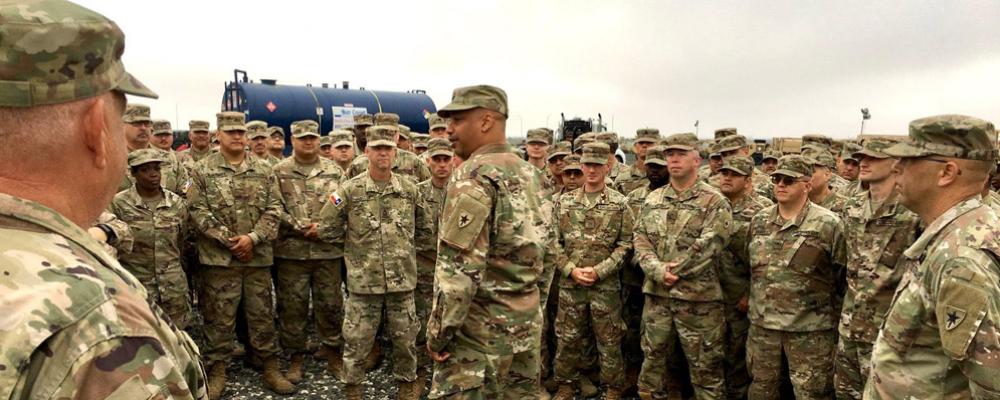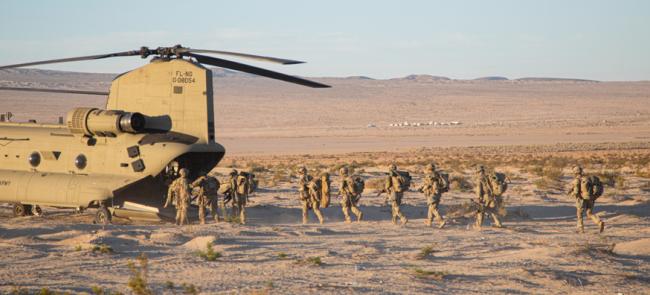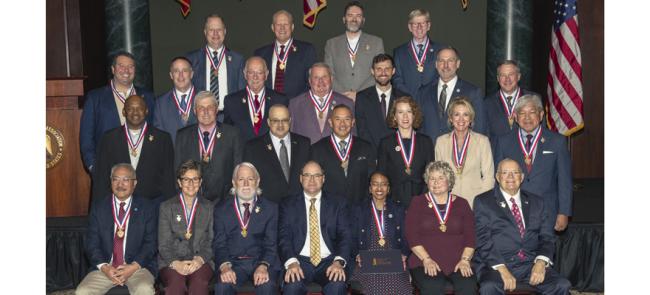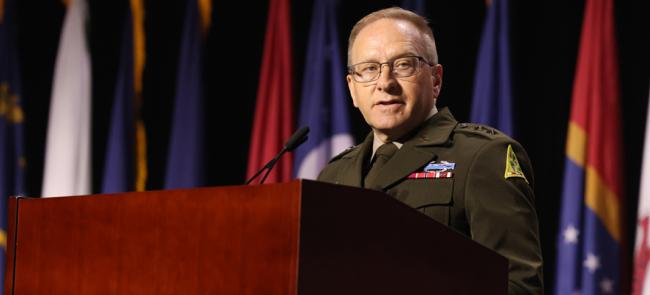
State Guards
The second Saturday in May found Sgt. Justin Stanton and perhaps 40 members of his Texas military medical unit in Houston training to load and strap down a stretcher bearing a 185-pound rescue dummy aboard a military helicopter.
It was among the emergency measures they might employ should their fellow Texans need their help if another hurricane hammers their state. Knowing how to care for victims and communicate with crewmembers could be critical.
Another training exercise during a Texas Army National Guard drill weekend? Guess again.
The medics, some of whom were full-time doctors and nurses, were volunteer members of the Texas State Guard’s 1st Battalion, 2nd Brigade. They were not being paid or accumulating retirement points.
Fact is, they were not obligated to be there at all. They were there strictly because they wanted to be. “There” being the National United States Armed Forces Museum and the helicopter a tandem-rotor HH-46E Sea Knight, a smaller version of the CH-47 Chinook, formerly flown by the Marines.
Welcome to one of America’s state defense forces. If you’ve never heard of these organizations, you’re not alone.
“I feel like the Texas State Guard is probably one of the best-kept secrets in the state because nobody has ever heard of us or know what we are,” says Stanton, who has served as a recruiter and a medical noncommissioned officer over the past nine years.
The same could be said of other military units that only operate solely under state control. Nearly every state has laws authorizing them, and 21 states and Puerto Rico have active SDFs, as state Guards are generically called, with different levels of activity, support and strength.
Their personnel numbers range from a couple hundred to a couple thousand, with California, Georgia, New York and Texas among the largest. Exact state strengths and a national total can be elusive because SDFs aren’t connected to a central agency like the National Guard Bureau, which tracks Army Guard and Air Guard personnel totals.
But recent figures from the State Guard Association of the United States, a voluntary networking entity, provide a good picture: A 2020 survey of 16 SGAUS members standing up to assist with the COVID-19 pandemic found 8,244 available personnel.
SDFs exist primarily to support the National Guard — to take its place should it be federalized and sent away to war as occurred during both World Wars; or to augment National Guard forces during domestic crises. That has especially been the case the last two decades.
“9/11 was really what changed it because there were so many missions,” says New York Brig. Gen. David Warager, the SGAUS president, who had already served 16 years in the New York Guard by 2001. “Then leveraging off that, there is domestic supportfor civilian authorities. For most states, that is the prime mission, to augment the National Guard.”
The collaboration is National Guard policy for domestic operations under state control.
“The NG may interact with SDFs to train and conduct exercises and maneuvers in support of domestic or civil support operations, as appropriate,” instructed Gen. Joseph Lengyel in June 2017 as NGB chief. “The NG will consider the SDF as any other State entity with respect to preparation for and participation in domestic or civil support operations, and the related use of Federal equipment, with the exception of specific restrictions.”
The policy is due for a five-year review this year.
I feel like the Texas State Guard is probably one of the best-kept secrets in the state because nobody has ever heard of us or know what we are.
—Sgt. Justin Stanton of the Texas State Guard
STATE DEFENSE FORCES have various names: The Georgia State Defense Force. The California State Guard. The Indiana Guard Reserve. The New York Guard. The Virginia Defense Force.
They have much in common, according to NGB Historical Services. They were authorized by federal law beginning with the National Defense Act of 1916 and the 1917 Home Guard Act that covered World War I. Twenty-two state Guards were formed by December 1917.
President Franklin Roosevelt authorized states to again organize state Guards in 1940 before the Second World War. Nearly 90,000 had mustered in 37 states by June 1941, and seven more states plus Hawaii, Alaska and Puerto Rico later came aboard, says NGB historian Bill Boehm.
Missions supporting civil authorities included the November 1942 Cocoanut Grove fire in Boston; race riots and labor strife in Texas, Michigan and Alabama in 1943; and the Great Atlantic Hurricane of September 1944, he says.
Title 32, which became law in 1956, “governs the establishment of state defense forces at any time,” Boehm notes.
State defense forces must be sanctioned by governors and fall within the adjutants general chain of command.
SDF officers hold state Title 32 commissions, as do National Guard officers. National Guard officers also have federal Title 10 commissions and can be mobilized by the president for duty at home or abroad. SDF personnel primarily serve within their states. They do not deploy overseas.
“We are not combat troops,” says Stanton, whose role conducting SGAUS podcast interviews with state commanders has given him a national perspective. “Our mission is humanitarian support. Our mission is support for local authorities during times of disaster and emergencies.”
SDFs have been busy lately. The Georgia State Defense Force alone had more than 300 members put in over 9,000 man-hours while supporting over 30 COVID-19 missions during 124 straight duty days in 2020, says Brig. Gen. Mark Gelhardt Sr., the force’s commanding general.
“Some members had lost their jobs and could volunteer,” Gelhardt says. “Others took time off from their jobs. It was the longest activation in our history.”
It was the same story for many other SDFs. State Guard troops performed many of the same pandemic missions as National Guard soldiers and airmen. They distributed food, vaccines and protective equipment; administered tests; screened people entering medical facilities; decontaminated personnel and facilities; helped process unemployment claims; and staffed mortuary trailers at hospitals.
Other missions have included multiple storm and wildfire responses. There have also been missions unique to particular states. For example, the Indiana Guard Reserve provided logistical support to an Afghan evacuee resettlement mission. Additionally, the Texas State Guard continues to augment the National Guard in Operation Lone Star, the state active duty mission on the U.S. southern border.
During such state missions, state Guard personnel and National Guard soldiers and airmen are often intermingled for some tasks. SDF commanders say it’s not uncommon for state Guard officers and NCOs to lead teams of National Guard and SDF personnel serving together.
SDF personnel with significant skills and experience, like cyber and medical, have also helped train National Guard units.
If you're going to put on the uniform, you'd better look like you belong in the uniform.
—Brig. Gen. Mark Gelhardt Sr., the commanding general of the Georgia State Defense Force
STATE GUARDSMEN, in most cases, have to buy their own uniforms. And tight state budgets mean they have very limited equipment and other resources for training.
So who would want to belong to an organization that requires so much and offers so little in tangible rewards? Probably for the same reasons people join volunteer fire departments, dedicate Saturdays to their church or assist at hospitals.
The desire to serve is the driving force — to help make their communities better, to do something useful with friends, neighbors and others who want to do the same, commanders say.
Incoming personnel are asked to serve for a specific amount of time, like three years, when they sign up, but they can leave at any time without penalty unless they are on state active duty orders, for which they are normally paid at state active duty rates.
“There is no contract coming in,” Stanton says. “Unlike the federal services, we’re not legally obligated to serve after becoming members. It’s a voluntary commitment. There can be a revolving door.”
He says Texas asks recruits to make a three-year commitment because “we’re going to make an investment in our time and attention to train them. The only way you can effectively build a force that is reliable for the governor is to have members who are reliable.”
“I think once somebody makes it past the first three years, they’re likely to serve for a much longer period,” Stanton says. “There’s a lot of adjustments that have to be made during those first three years. Then I think it just becomes a part of who you are.”
Most new personnel, claim longtime members, fall into one of three categories: They were in the military and want to remain in uniform or return somehow. They wanted to join but were turned down, and still want to serve. Or they just want to find out what it’s all about.
Estimates are a little less than half the force nationwide has prior military service. The New York Guard provides an example of the resulting mix. A medical condition prevented him from entering the U.S. Naval Academy, Warager explains, so he joined the Empire State’s Guard in July 1985 and was appointed commanding general in 2018.
His successor, Brig. Gen. Peter Riley, served for 30 years in the New York Army Guard and retired as a colonel in May 2019. He joined the New York Guard in 2020 because of the pandemic and assumed the state command in September 2021.
The typical member tends to be older than the average National Guard soldier or airman. SDF spokesmen say state Guardsmen often join in their 30s and 40s after settling into families and careers, whereas most National Guard recruits are somewhere between high school and their 20s.
Entry requirements are not nearly as stringent as they are for joining the traditional uniform services. In Georgia, for example, recruits must clear a background check and “be in relatively appropriate shape,” Gelhardt says. Four duty levels range from being fit enough to “go into the woods with a backpack” to sitting at a desk and not going to the field, he adds.
“We’d like you to be within the height-weight standards of the active military,” says Gelhardt, a retired Army lieutenant colonel. “But we’ll look at you, talk to you and make a determination on a case-by-case basis. If you’re going to put on the uniform, you’d better look like you belong in the uniform.”
Most SDFs have initial entry training for those new to military service. It’s only a few days and the rigors bear little resemblance to Army boot camp. The curriculum is focused on the basics: customs and courtesies, drill and ceremony and wear of the uniform.
Monthly drills are conducted differently from state to state, and annual training varies from four days to a week.
All this, some acknowledge, can create skepticism about SDF members among those who pay a more a demanding price to wear the uniform.
“I know from personal knowledge what a National Guard member goes through in basic training. And I know from personal experience what our entry training is,” Stanton says. “So I would never say to a National Guard member that I am the same as you because I have too much respect for what they do and what they’ve accomplished to elevate myself into that position.”
SDFs are always looking for new recruits, especially those with professional experience in skills they are often asked to provide in an emergency: communications, IT, public relations, medicine, the law and the clergy.
There are also people that state forces don’t want in their ranks, namely those with ties to or affinity for anti-government militia groups.
“We don’t want those folks because they’re not there to serve the betterment of society,” Warager says. “Most of our SDFs are not armed. Those other militia groups are not us. They may sneak in for a little while, but not long. We don’t tolerate it.
“The fact that they’re getting press and referred to as ‘militia’ doesn’t help us,” adds Warager, underscoring the SDF’s lack of a distinct identity.
Media people sometimes see personnel in essentially the same military uniforms distributing food and water or filling sandbags and identify them all as National Guard, explains Stanton and others. That state flags, not the U.S flag, are worn on right shoulders may be overlooked.
And when SDFs do get press attention, it’s often not the kind commanders seek.
In 2007, the New York Times reported many senior officers in the New York Guard had little or no formal military training despite some holding general officer ranks. In 2015, Gov. Greg Abbott made headlines when he ordered the Texas State Guard to monitor a special operations exercise across the Southwest. He said he did so to quell public concern that Jade Helm 15 was a covert effort to institute martial law.
Additionally, SDFs appear to come and go. Three states have deactivated their forces within the past decade — Alabama in 2014, Massachusetts in 2016 and Missouri this year.
Missouri’s SDF ceased operations because “it provided little or no benefit to the National Guard,” according to reports. “This should act as a warning for those less active State Defense Forces. It is up to the leadership . . . to seek out new and better avenues to assist their National Guard,” says Jean Marciniak, the StateDefenseForce.com administrator.
Meanwhile, Gelhardt says Gov. Brian Kemp wants the Georgia State Defense Force to grow from its current 400 personnel to “800 to 1,200 members,” and Florida Gov. Ron DeSantis has brought the Florida State Guard back to life after it was disbanded following World War II.
DeSantis, a Navy Reserve officer and Iraq War veteran, announced in December that he wanted a dedicated emergency force that doesn’t answer to the federal government, reported Florida Politics.
“If you love the state of Florida, have a desire to help your community, and have skills beneficial to protect the state from a disaster, we encourage you to apply to join the FLSG,” states a news release.
The announcement was a political football for the Republican governor. “Democrats accused him of trying to establish a ‘vigilante militia’ and ‘secret police,’” reported Bloomberg News.
But elected officials on both sides of the aisle have long said the Florida National Guard’s 12,000 soldiers and airmen are insufficient to respond to the state’s “worst day.” Florida is prone to hurricanes.
DeSantis has since appointed a Florida State Guard commander, retired Marine Corps Lt. Col. Chris Graham, and 1,200 people have reportedly volunteered to serve in the rejuvenated 400-member force with an approved $10 million budget for 2023.
Politics aside, SDF members feel a bond with members of the National Guard. A desire to serve their people and their states, to be part of an organization that is bigger than themselves. They believe they belong to the same team in the same fight.
Bob Haskell is a retired Maine Army National Guard master sergeant and a freelance journalist in Falmouth, Mass. He may be contacted at [email protected].



